A Complete Guide to Pinellas County’s Heritage Village
In the 1800s, Pinellas County did not exist. Rather, the peninsula of land that sat between the Gulf of Mexico and Tampa Bay was part of Tampa’s Hillsborough County and as sparsely populated as the rest of the state.
The most densely populated county in Florida today, Pinellas County’s history lives on at Heritage Village in Largo. “The mission of Heritage Village is to collect, preserve, and interpret the history of Pinellas County within the context of Florida history.” This county park currently houses 33 historic buildings, including the oldest existing structure in Pinellas County.
This ultimate guide to Heritage Village near Tampa showcases many of those early structures, as well as stories surrounding the buildings and other exhibits found in Heritage Village.
Wander Florida is fully reader-supported. For that reason, this article may contain affiliate links. If you make a purchase through one of the affiliate links, I may earn a small commission at no additional cost to you. This revenue helps keep Wander Florida free and updated. I only recommend products or services that I would use myself. Read the full disclosure here.
The buildings at Heritage Village originally stood in other parts of the county. Over the years, some were donated while the Pinellas County Historical Society purchased others. No matter the manner of acquisition, they moved all the buildings to the 21-acre park where they were preserved and interpreted to represent each building’s place in time.
Spend part of your day at Heritage Village, then head next door to the Florida Botanical Garden, 30 acres of plants, flowers, and various gardens next to Heritage Village. Both are free and make for an educational and fun family day.
Note: The text for all buildings comes directly from informational plaques erected at each site in Heritage Village.
Historic Buildings at Heritage Village
The main focus of Heritage Village is a place for historic buildings from around the Pinellas County area to find a permanent home. As such, the majority of the attractions at Heritage Village are historic buildings.
H.C. Smith Store

- Built: 1915
- Original location: 468-470 Sixth Avenue South, St. Petersburg, FL
- Moved: 1988
Between 1900 and 1920, St. Petersburg population soared from 1,575 to over 14,000. This store opened in the Mound Park neighborhood to serve nearby communities like Roser Park. Shoppers came to this small store because it had it all – groceries, clothing, and other necessities. From 1915 to 1955, this building had different owners and names, and for most years, thrived. By the 1950s, small stores like this struggled to compete as shoppers flocked to downtown stores or air-conditioned shopping centers and later to mega malls.

Fourth Street, one block east of the store, became the main north-south roadway with the opening of Gandy Bridge between St. Petersburg and Tampa in 1924. Considering that Charles Preston purchased the building in 1935 for $3,000 (a sizable amount of money at the height of the Great Depression), this store likely received plenty of business from the increased traffic.
House of Seven Gables

- Built: 1907
- Moved: 1976
- Originally located: 418 Bay Avenue, Clearwater
This impressive home rested on the bluff in downtown Clearwater near the Pinellas County Courthouse. From its wrap-around porch, occupants enjoyed magnificent views of Clearwater Bay and the developing city.
The elegant residence contains 13 rooms with a spacious living area suited for Edwardian tastes. For 6 decades, many people and families made this place a home. The home has classic late Queen Anne style features, including an asymmetrical shape, wings, and gables facing in multiple directions, an impressive porch, and gingerbread details.
David and Mary Starr visited the settlement of Clear Water Harbor in early 1886 and purchased land. David, a savvy entrepreneur, commuted for 20 years between their hometown of Rockford, Illinois, where he ran a manufacturing business, and Pinellas with his real estate and business enterprises. In 1896, the couple bought land for a home, waiting a decade to build their grand seasonal residence where they lived until 1917.
In the early 1920s, Arthur Cornwell, an Episcopal minister, rented the home for his family. As rector of Church of the Ascension in Clearwater, he planned the opening of a new sanctuary. At home, he graded papers for his other full-time job – teaching at the city‘s high school. Cornwell’s three socially active daughters swam, fished, went boating, held card parties, and enjoyed picnics.
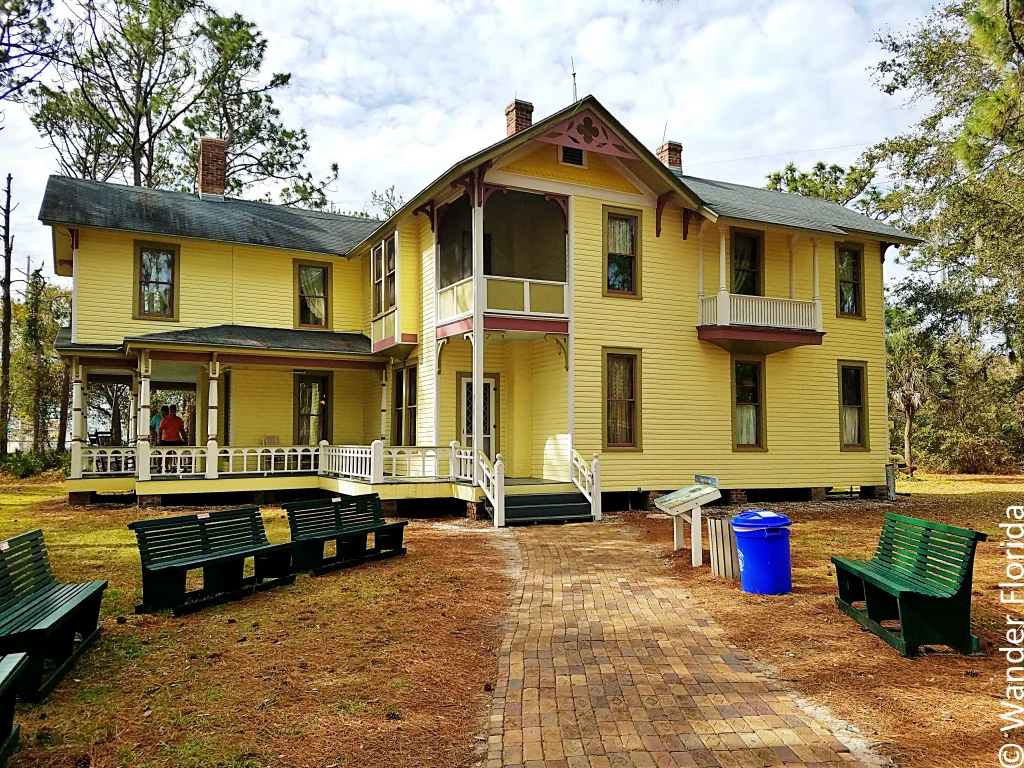
Chester and Lucy Masslich owned the home from 1925 to 1943. They converted it into Seven Gables Inn, a boarding house, and hired families to manage the property. Single adults, binder boys, and winter residents rented furnished rooms. For the next 30 years, from 1944 to 1974, Seven Gables was again a private home for the Dietrich and Hemerick families, among others.
Yesteryear I Lived in Paradise ➡️ Read the amazing story of a father and daughter who homesteaded present-day Caladesi Island.
Lowe Barn

- Built: 1911-1912
- Original location: Off Indian Rocks Road, Largo
- Moved: 1976
Wesley and Mary Lowe farmed a variety of crops in the Anona region, a community that grew up around Wesley’s father’s homestead. As their family business grew, so did the need for a bigger barn. By 1911, they replaced a smaller barn with this one.
Wesley’s son, Sumner, recalled “handing wood up from the small barn” as they salvaged the best wood for the new building. Barns like this were not a common sight on the Pinellas landscape because cattle were allowed to range freely in Florida until 1949. Other agriculture, like citrus, did not require storage like this.
The Lowes stored hay in the barn, and they kept horses and cows. They also kept a horse-drawn buggy and wagon in the barn before they purchased their first automobile. At that point, the barn doubled as a garage where farm animals shared space with the family’s Model T. Wesley Lowe used cypress lumber, a rot resistant wood, as the foundation for this barn. When Paul Randolph purchased the property in the 1940s, he added the stables and pens seen today on each side.
Lowe House

- Built: 1888
- Originally located: Off Indian Rocks Road, Largo
- Moved: 1991
In 1888, Wesley Lowe supervised the construction of this house in Anona for his wife, Mary, their children, and his father, Captain Thomas Lowe. The Lowes branched out from the shipping business to become farmers, raising cattle and a variety of crops. For family fun, they enjoyed candy pullings, horseback riding, and swimming in the Gulf of Mexico.
Commonly known as a homestead-style house, Wesley built this two story structure of pine and cypress with decorative details on the side porch roof. The large windows extend to the floor, which enhances air circulation through the house and may also be a design feature influenced by Wesley’s father’s Bahamian roots, where this style is popular.
McMullen-Coachman Cabin

- Built: 1852
- Originally located: Corner of Coachman Road and Old Coachman Road, Clearwater
- Moved: 1977
James and Elizabeth McMullen built this 1-1/2 story log cabin near Alligator Creek, part of present day Clearwater. They raised livestock and farmed, growing a variety of crops, including cotton. Their cattle ended up on dinner plates throughout the South and even Cuba.
The McMullens pursued opportunities during the turbulent years following the Civil War by selling cattle to Cuba, where the economy was stable. By 1869, the family manufactured syrup barrels and held sugar cane grinding parties. Later, they converted their cotton fields into citrus groves.
Elizabeth Campbell McMullen, a Hernando county native, was probably the first midwife in the area. By 1900, this cabin witnessed the birth of nearly 60 children, including many of the extended McMullen family. During the Civil War, Elizabeth protected the homestead and raised their children while James served with the Confederate Cow Cavalry.
For 20 years, this was the most substantial home in Upper Tampa Bay. And with Elizabeth’s hospitality, it was a favorite stop for overland travelers to enjoy an evening of dancing to guitar, fiddle, and organ music.
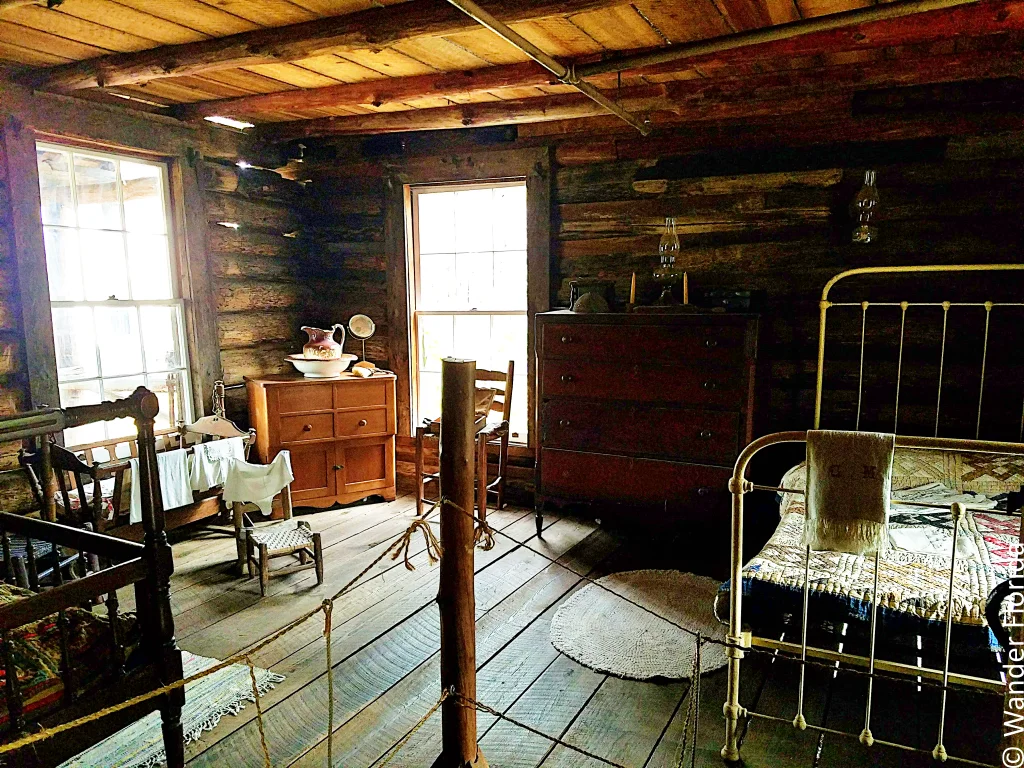
In 1902, Solomon and Jessie Coachman purchased the McMullen homestead, including cabin and about 240 acres for $8,100. They modernized the cabin by adding glass to the open windows and sealing the gaps between the logs.
Solomon’s endeavors included a sawmill operation, a large general store, growing citrus, and a leader in the movement to separate Pinellas from Hillsborough County. The cabin was both home and office. Solomon sponsored many political rallies while Jessie served lemonade and cookies. Their efforts paid off and in 1912, Solomon became the first chair of the newly created Pinellas County Board of County Commissioners.
McMullen House

- Built: 1868
- Original location: 1551 Rosery Road, Largo
- Moved: 1992
Daniel and Margaret McMullen and their children built this home in 1868. They came to the Pinellas peninsula in the 1850s, following in the footsteps of Daniel’s older brother, James. During the Civil War years they left, returning by wagon in late 1865.
On their 160-acre homestead, they raised livestock and grew crops. They shared the Florida frontier with the bears, deer, and turkey often seen on their land. Squeals from the pigs woke the children at night when bears, looking for their next meal, raided the pigpens.
Built of native pine, the home had two formal rooms and two sleeping rooms connected by a dogtrot breezeway, an architectural style known as Florida Cracker. Successive generations added rooms to the home and outbuildings to the property.

The McMullens grew cotton, sugar cane, and vegetables. By the mid-1870s, Daniel converted some cotton fields to citrus groves. The children, who helped in the fields, liked this change, as they preferred to pick oranges to prickly cotton. The family raised chickens and hogs but were best known for their cattle.
By the 1890s, they owned the largest herd of cattle in Pinellas County, numbering 1500 head. Daniel McMullen was also part owner of a mercantile store, the Farmers’ Alliance Exchange, and in the last two years of his life, helped established the Bank of Largo.
McMullens lived in this home for 123 years. “Uncle Dan” McMullen lived here for 40 years with his family. Around 1910, his daughter and her husband lived here and raised their nieces and nephews and Dan’s granddaughter, Nancy McLaughlin. She lived in the home for more than 80 years until 1992. McMullen-Booth Road in Safety Harbor is named after this family.
Moore House

- Built: 1879
- Original location: Near Highland Avenue and Sunset Point Road, Clearwater
- Moved: 1981
This native pine home typifies the average farmhouse of the late 19th century. The original two-room home had full length covered porches on the front and back, a welcome relief from the Florida heat before air-conditioning.
The Moores converted the back porch into two rooms and built an additional room along the front porch. Commonly known as the Florida Cracker style, the home’s design follows the Gulf Coast Cottage style found along the coast of the Deep South.
George Washington and Frances Moore left Kentucky in 1875 to follow his parents to the Pinellas Peninsula. They built this house next to his parents’ plot of land just east of Stevenson’s Creek in Clearwater. George, a blacksmith and machinist, and “Fanny” had five children. They grew vegetables on their land and raised pigs and cattle, which roamed freely.
In 1887, while on a business trip to Tampa, George contracted yellow fever and died. The Moore’s son, Moffett, became a prominent Dunedin business owner. He took advantage of the land boom, operated several businesses, and even became Dunedin’s first historian.
Safety Harbor Church

- Built: 1905
- Moved: 1977
This church building was in a central location in the growing community of Green Springs, renamed Safety Harbor in 1917. Early parishioners included pioneers from the upper Pinellas peninsula such as the McMullens and Booths.
The congregation hosted many events, including a Methodist coffee hour and the always popular potluck dinners. Coffee hours included devotional readings, fellowship, refreshments, and occasional entertainment. After outgrowing the church, this congregation opened a new sanctuary in 1960 and converted this structure into a Sunday school classroom and office space.
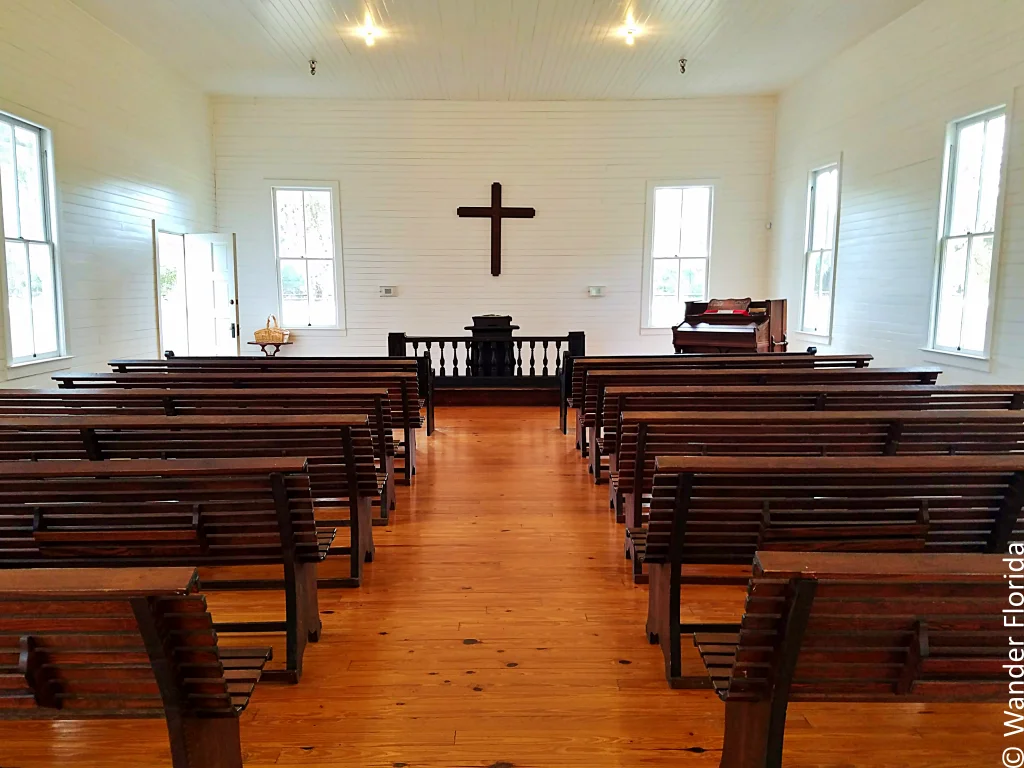
Circuit riding Methodist pastors served more than one church, traveling frequently between congregations. Pastors from this church also conducted religious services for churches in Anona, Bayview (now part of eastern Clearwater), Curlew, Largo, Ozona, Sutherland (now Palm Harbor), and other locations.
This simple wood frame structure emphasized the function rather than an elaborate ornamental design. The wood for the tongue-and-groove planking along the walls, ceilings, and floors came from E. H. Coachman’s sawmill at Philippe Hammock, now part of Philippe Park.
You Might Like ➡️ Things to Do in Safety Harbor
Sponge Warehouse
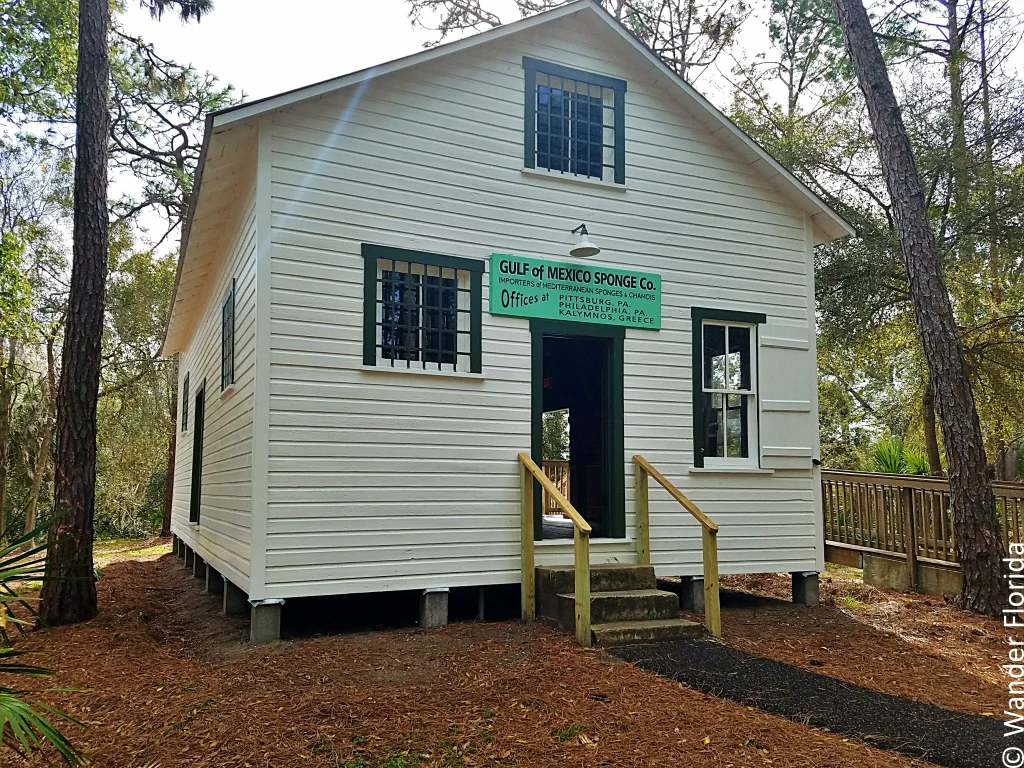
- Built: 1930
- Original location: 122 Roosevelt Blvd, Tarpon Springs
- Moved: 2004
Around 1930 Drosos Alahuzos opened a wholesale sponge business in this wood frame warehouse, part of his family’s Philadelphia based business. After his death in 1955, another Philadelphia sponge dealer, George Kousaleos with the Gulf of Mexico Sponge Company, purchased the warehouse. He conducted business from there until the mid 1970s.
Both the Alahuzos and Kousaleos families came to America from Kalymnos, known as “sponge divers’ island”, one of a chain of Greek islands in the Mediterranean Sea.
This simple frame warehouse, with a separate cement block sponge washroom in the rear, has the original signs on the building noting the location of the company’s offices in Pennsylvania and Greece. The building has large side doors used for loading and unloading sponges.
You Might Also Like ➡️ The Unique History of Tarpon Springs
Sulphur Springs Train Depot

- Built: 1920s
- Original location: Sulphur Springs
The only structure in the Village to come from outside of the County, it was originally in Sulphur Springs, a small community on the north side of Tampa, but it is typical of the early railroad depots that once dotted our area. Before railroads came to Pinellas, settlers traveled by foot, buggy, on horseback or by boat.
The state’s first railroad ended at Cedar Key, nearly 100 miles north of the Pinellas Peninsula. In the 1880s, Russian immigrant Peter Demens launched his Orange Belt Railway in Pinellas and Henry Plant brought his railroad to Tampa.
Business ventures and tourism flourished after regular railroad service came to Pinellas. It improved efficiency in transporting crops and other goods to distant markets and bringing people here to enjoy the climate.
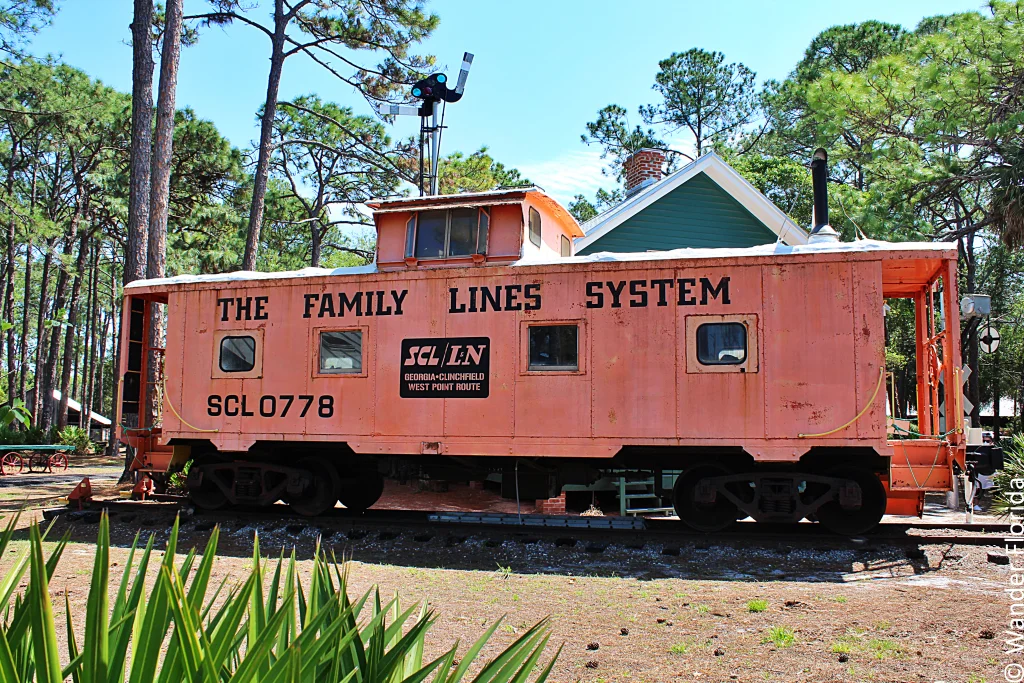
In the 1840s, staff at the Auburn & Syracuse Line Railroad in New York came up with the idea for a caboose. The last car of a freight train, the caboose housed the crew and the conductor’s office. A 5-member crew included an engineer, firefighter, conductor and 2 brakemen. The conductor, who rode in the caboose with the brakemen, was the boss on the train. Riding up front, the engineer drove the train, and the firefighter kept it fueled.
During the early years of steam power, brakemen manually stopped each car as the train slowed to a stop. By the 1870s, with the invention of automatic air brakes, their duties shifted to include flagging signals to the engineer. With advancements in technology, including computers and radios, today’s freight train crew only requires a conductor and engineer. The caboose, once a proud symbol of our national railroad system, is becoming extinct.
Union Academy

- Built: 1916
- Originally located: Pinellas Avenue, Tarpon Springs
- Moved: 1981
By the end of the Reconstruction era in 1877, laws required racial segregation throughout the South, including Florida. Schools for black children lagged behind their white counterparts. Black students attended shorter terms, occupied crowded classrooms, and used outdated textbooks discarded from white schools.
Tarpon Springs had a one room school for African American children, and by 1917 the class size had swelled to 73 students. To relieve overcrowding, officials approved a new four-room structure named Union Academy on a small plot of land where classes began in 1919.
This building, probably built as a World War I barrack or warehouse, was a portable classroom at the all-white Tarpon Springs Elementary for 20 years. In 1942, school officials moved the building to the Union Academy campus, the established elementary school for the ‘colored’ students in Tarpon Springs. While at Union Academy, the building served as a classroom, cafeteria, and home economics room for over 20 years.
In 1964, school officials improved Union Academy again. Leaders in the black community purchased this building and moved it down the street to become home to the “Better Boys Club” for 15 years. Heeding the club’s motto, “Building boys is better than mending men”, club leaders nurtured African American boys and teenagers who gathered here when few organizations welcomed them.
Walsingham House

The Walsingham House is interpreted as a doctor’s home and office at Heritage Village. Though never a doctor’s office, the home did serve as the family home for the Walsingham family, a civic center of the area, and later as a boardinghouse/rental property with access via a set of exterior rear stairs.
- Built: 1915
- Original location: 12125 Ridge Road, Largo
- Moved: 1984
Jesse Walsingham moved to Pinellas (then western Hillsborough County) in the 1890s. He fell in love with Mary O’Quinn, a member of the pioneer McMullen and O’Quinn families. The two exchanged vows and settled in the Largo area before starting a family.
For the next 30 years, Jesse engaged in various occupations. He traveled the peninsula delivering ice, operated a meat and citrus packinghouse, managed a hardware store, worked as a butcher, and sold fertilizer.
After its construction, the house became a center for the Walsinghams’ agricultural, commercial, and civic activities, including Jesse’s leadership in the Largo Truck Growers’ Association, the formation of Pinellas County in 1916, and the Largo Women’s Club’s plans for the first Pinellas County Fair in 1917. Walsingham Road and Walsingham Park, both in Largo, are named for the Walsingham family.
Williams Park Bandstand
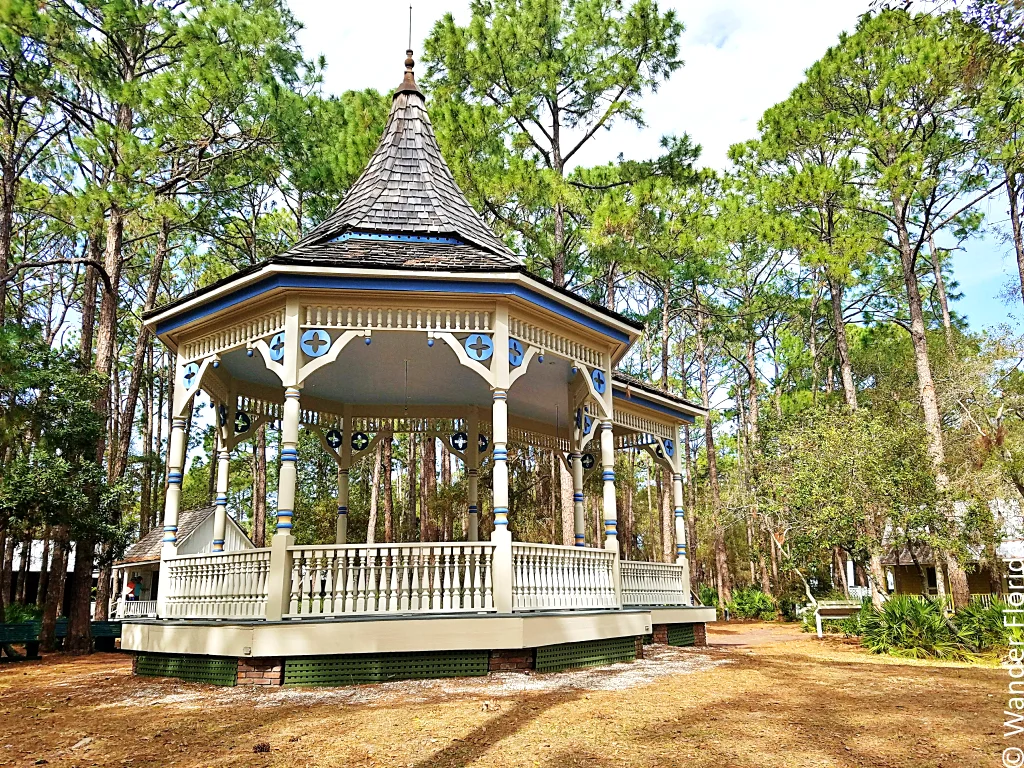
- Built: circa 1894
- Replica: 1981
During the late 1880s, St. Petersburg was a sleepy pine scrub village striving to be cosmopolitan. Northerners moving to this community, both permanently and seasonally, helped transform the aspiring town by bringing culture and new ideas.
During the early 1890s, the place known as City Park was unappealing with its tall grass, mud puddles, and roaming livestock and wild animals. In 1893, a group of women took charge and formed the Park Improvement Association. One of their first projects was a fence around City Park. The ambitious women of the Park Improvement Association sold ice cream, lemonade, candy, and other treats to raise funds for the fence.
Built in 1894, the new fence kept out pigs, chickens, and cows that still roamed the area. Next, the women raised funds for a bandstand at the north end of the park. Since St. Petersburg had no other performance areas, the new bandstand became the center stage for concerts and community gatherings.
Williams Park was named after John and Sarah Williams, who came to the Pinellas Peninsula in 1875. These early settlers gave land for the park from their homestead. Sarah, working with her husband, negotiated with Peter Demens to bring the Orange Belt Railway to St. Petersburg in 1888. Sarah was an active member of many civic organizations. Naming the park and bandstand for them honored their significant contributions to the growth of this city.
Other Attractions at Heritage Village
Pinellas County Heritage Village houses several historic collections of personal items which date from the 1800s to the mid-1900s. Many of the items in the museum were donated alongside buildings on-site, although many items also came to Heritage Village separately.
The Roy Helms Gallery permanently displays an exhibit named Pinellas Passport. This exhibit explores the history of Pinellas County, including coastal living, agriculture, community life, and tourism. The McKay Creek Boat Shop showcases the life and times of local boat builder Clark Mills and the importance of the Optimist Pram design and sailing in Pinellas County.



Special Events at Heritage Village in Largo
The Village holds several special events each year. Chief among them is the Country Jubilee and Flea Market held every year in October. The event features the opportunity to shop for a wide selection of handmade arts, crafts and seasonal decorations. Visitors also enjoy music, tours of select historic structures, and demonstrations of traditional folk art. Children are encouraged to wear their Halloween costumes for an hour of trick-or-treating in the afternoon.
Other special events include the Easter weekend classic and vintage car show, Farm City Days hosted by the Pinellas County Farm Bureau, and ROC Day by the Pinellas Weavers Guild demonstrating fiber crafts such as weaving and spinning.


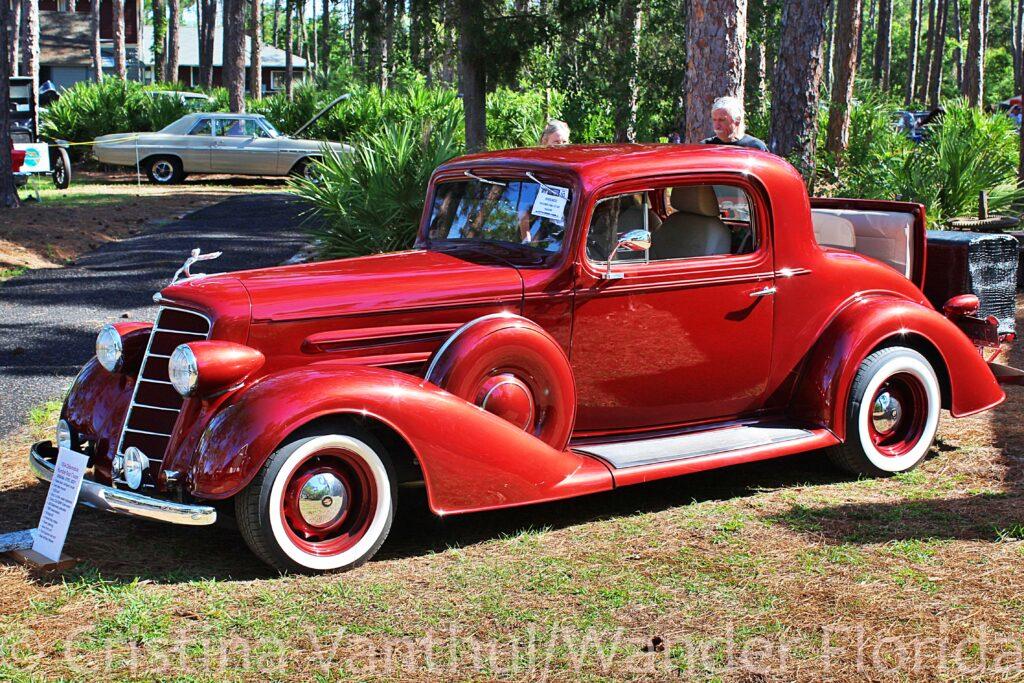
What to know before you go –
Final Thoughts on Pinellas County Heritage Village
And there you have it! Everything you need to know about Heritage Village in Largo. Now that they know this information, the next step is to plan your visit, right? In the meantime, check out my article about the Clearwater Historical Society to learn more about the area’s history.
SIGN UP for the NEWSLETTER. Stay up-to-date with the latest blog posts, travel tips, and discounts.
Let’s Connect!
Follow us on Facebook, YouTube, and TikTok. Also, please check out my Facebook group, Florida Travel Tips & Secret Spots, to get travel tips, discounts, secret spots, and hidden gems.
Did you know you can grab one of my photos for your home or office? Visit my Etsy shop to see what’s available right now! And thank you for your support!
Travel Resources:
These are the places I first go when planning or booking travel. They ARE affiliate links so if you use one I may earn a small commission (at no cost to you) and (bonus!) it’ll help me keep running this site. Visit my travel resources page to see all of the services and gear I recommend.
Flights: We always check flight prices and information on Way Away first.
Hotels: We use Expedia to compare and book hotels. We also love Booking.com for boutique hotels and B&Bs.
Vacation Rentals: For vacation rentals and other non-traditional lodging options, VRBO is our go-to.
Tours & Tickets: We use Viator for private tours and unique experiences.
Rental Cars: Though we prefer to experience a city through its public transportation, there are times when a rental car is needed and in those instances, we use Discover Cars.
Travel Insurance: No one wants to need it, but it’s great to have when you do. VisitorsCoverage is our go-to provider.

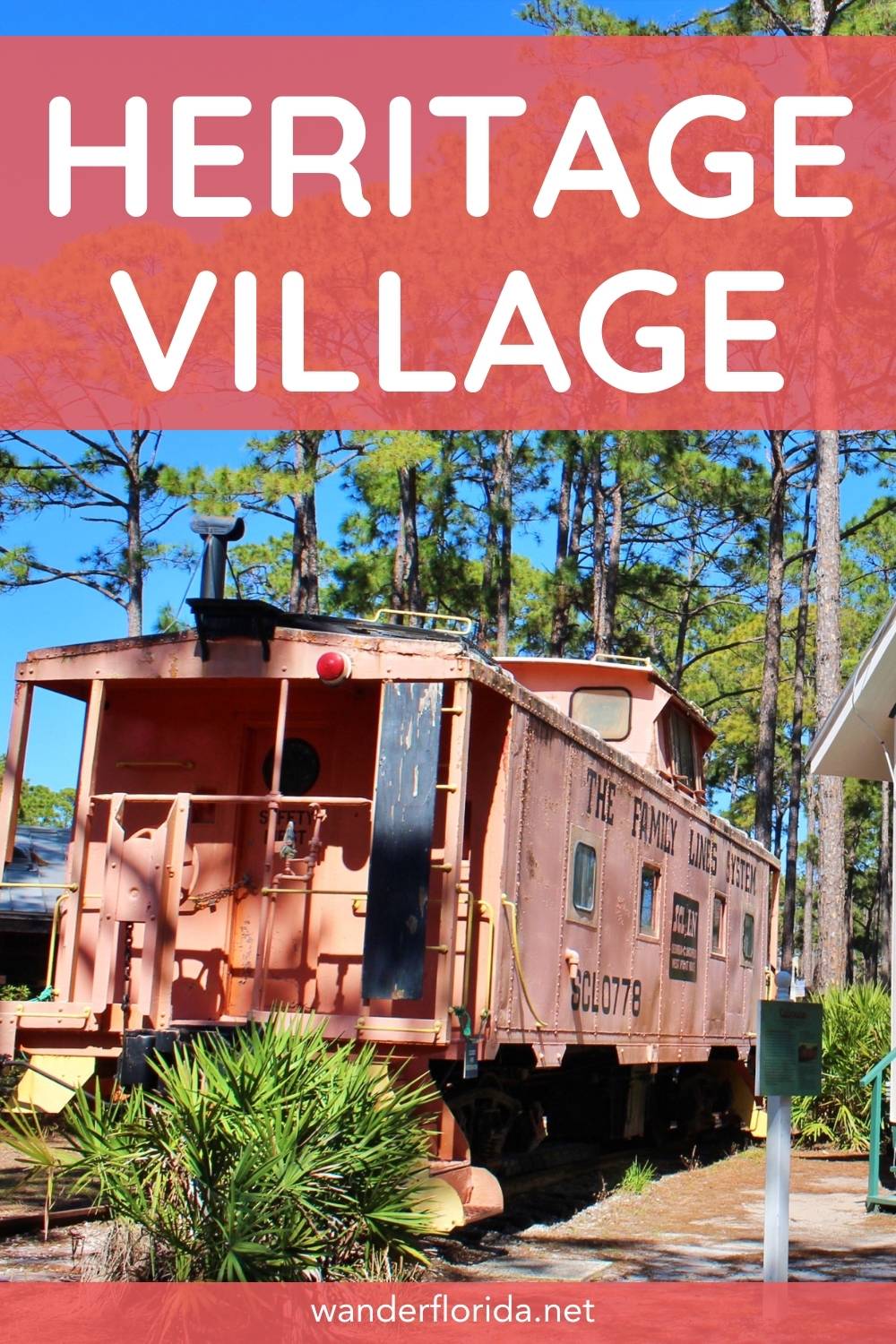
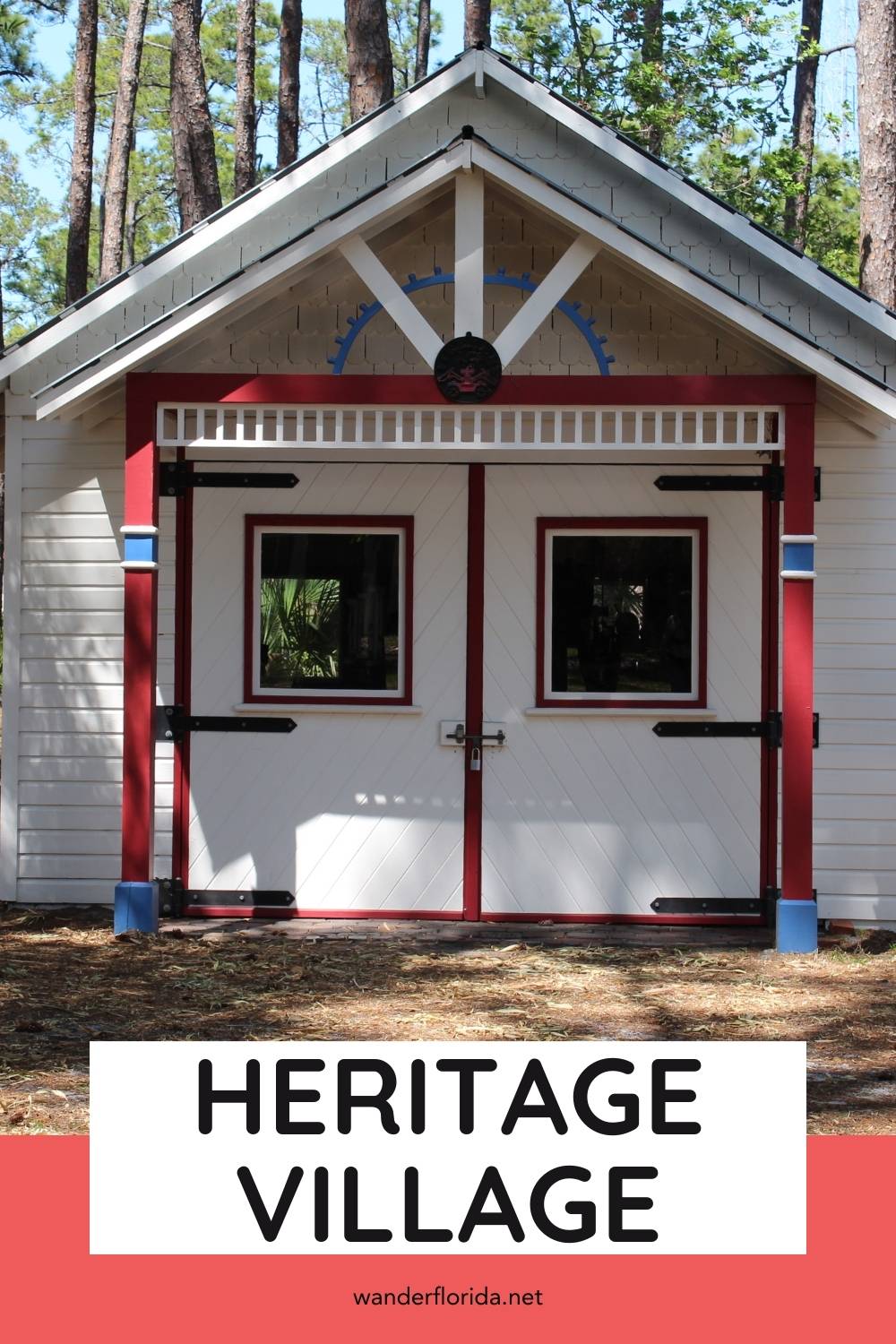

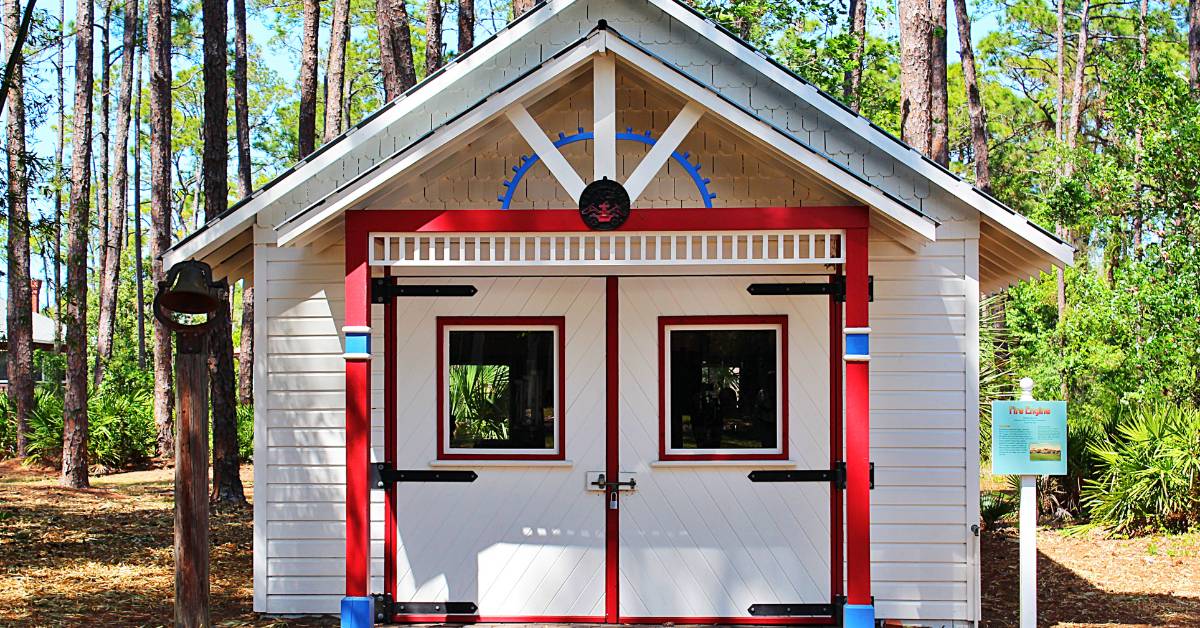
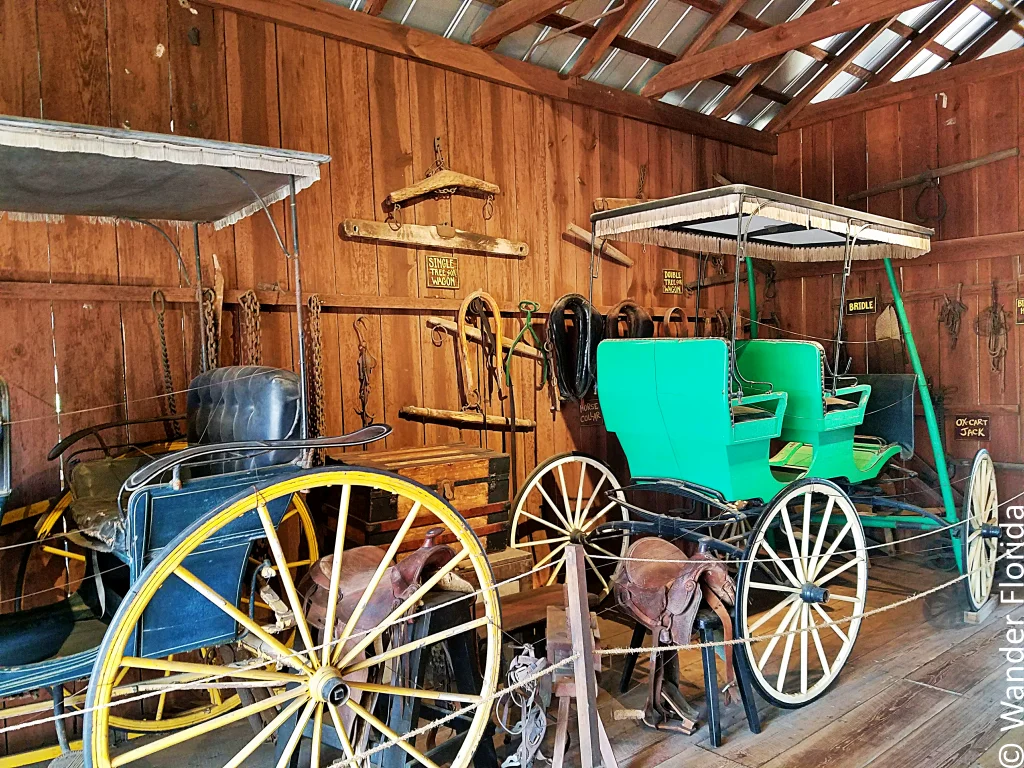



The House of Seven Gables intrigued me the most. I would love to own a home this massive and big, also it interesting to see such historic homes in its modern state today.
This looks like such a fun place to visit! I love visiting historical places and learning about life back in the day.
These houses are absolutely stunning, I wish we had more like them in the UK. The church is absolutely stunning too x
Cris, thank you so much for this post. It’s well written and informative. I love historic houses and I will definitely go and check this out when I get a chance to visit Florida. Thank you!
This is such a cool place to be. I definitely can see myself exploring all day and never getting bored.
I love how quaint the architecture is! Looks like a fun place to visit and feel like you’re in another era!
xoxo
Annie
Oh my goodness what an amazing looking place to go and spend some time exploring. I love these historical places, really educational too!
What an in depth post! I’ve been thinking of taking my children to visit a similar location in Maryland…wonderful educational tool!
I love learning history of places and their heritage. These houses are so adorable and love the vibrant colours. I would love to visit such a place.
So cool, I would love to explore this village. All the houses and buildings look neat. I love history, so I could spend hours here going through everything.
It’s so easy to spend a whole day here poking into all the little nooks and crannies of these old homes!
Those houses are so cute, somehow reminds me of Glitch series :))
http://www.bigdreamerblog.com
I haven’t seen Glitch, but if it has beautiful houses, I’m in!